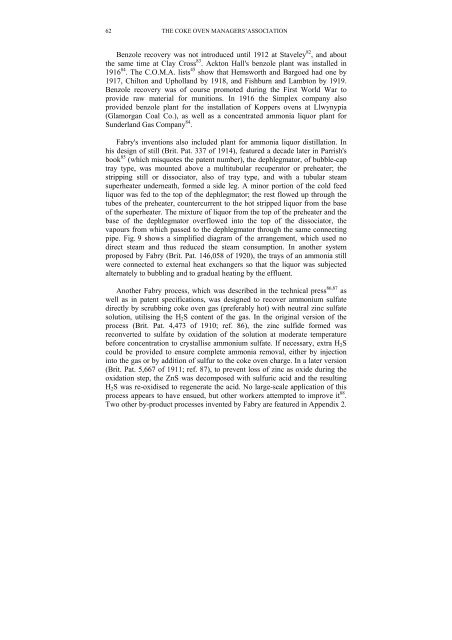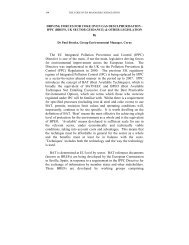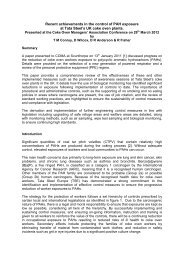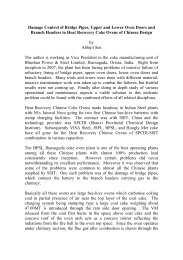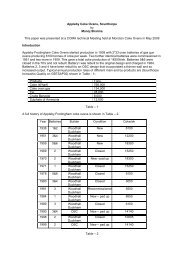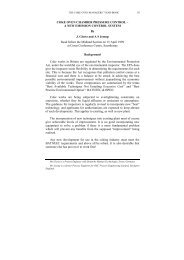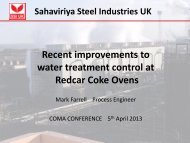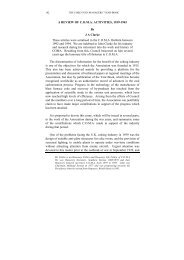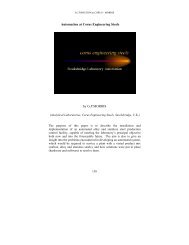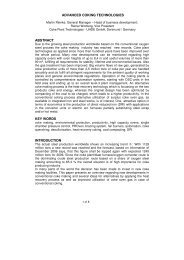CHAIRMAN'S ADDRESS - Coke Oven Managers Association
CHAIRMAN'S ADDRESS - Coke Oven Managers Association
CHAIRMAN'S ADDRESS - Coke Oven Managers Association
- No tags were found...
You also want an ePaper? Increase the reach of your titles
YUMPU automatically turns print PDFs into web optimized ePapers that Google loves.
62 THE COKE OVEN MANAGERS’ASSOCIATIONBenzole recovery was not introduced until 1912 at Staveley 82 , and aboutthe same time at Clay Cross 83 . Ackton Hall's benzole plant was installed in1916 84 . The C.O.M.A. lists 45 show that Hemsworth and Bargoed had one by1917, Chilton and Upholland by 1918, and Fishburn and Lambton by 1919.Benzole recovery was of course promoted during the First World War toprovide raw material for munitions. In 1916 the Simplex company alsoprovided benzole plant for the installation of Koppers ovens at Llwynypia(Glamorgan Coal Co.), as well as a concentrated ammonia liquor plant forSunderland Gas Company 84 .Fabry's inventions also included plant for ammonia liquor distillation. Inhis design of still (Brit. Pat. 337 of 1914), featured a decade later in Parrish'sbook 85 (which misquotes the patent number), the dephlegmator, of bubble-captray type, was mounted above a multitubular recuperator or preheater; thestripping still or dissociator, also of tray type, and with a tubular steamsuperheater underneath, formed a side leg. A minor portion of the cold feedliquor was fed to the top of the dephlegmator; the rest flowed up through thetubes of the preheater, countercurrent to the hot stripped liquor from the baseof the superheater. The mixture of liquor from the top of the preheater and thebase of the dephlegmator overflowed into the top of the dissociator, thevapours from which passed to the dephlegmator through the same connectingpipe. Fig. 9 shows a simplified diagram of the arrangement, which used nodirect steam and thus reduced the steam consumption. In another systemproposed by Fabry (Brit. Pat. 146,058 of 1920), the trays of an ammonia stillwere connected to external heat exchangers so that the liquor was subjectedalternately to bubbling and to gradual heating by the effluent.Another Fabry process, which was described in the technical press 86,87 aswell as in patent specifications, was designed to recover ammonium sulfatedirectly by scrubbing coke oven gas (preferably hot) with neutral zinc sulfatesolution, utilising the H 2 S content of the gas. In the original version of theprocess (Brit. Pat. 4,473 of 1910; ref. 86), the zinc sulfide formed wasreconverted to sulfate by oxidation of the solution at moderate temperaturebefore concentration to crystallise ammonium sulfate. If necessary, extra H 2 Scould be provided to ensure complete ammonia removal, either by injectioninto the gas or by addition of sulfur to the coke oven charge. In a later version(Brit. Pat. 5,667 of 1911; ref. 87), to prevent loss of zinc as oxide during theoxidation step, the ZnS was decomposed with sulfuric acid and the resultingH 2 S was re-oxidised to regenerate the acid. No large-scale application of thisprocess appears to have ensued, but other workers attempted to improve it 88 .Two other by-product processes invented by Fabry are featured in Appendix 2.


